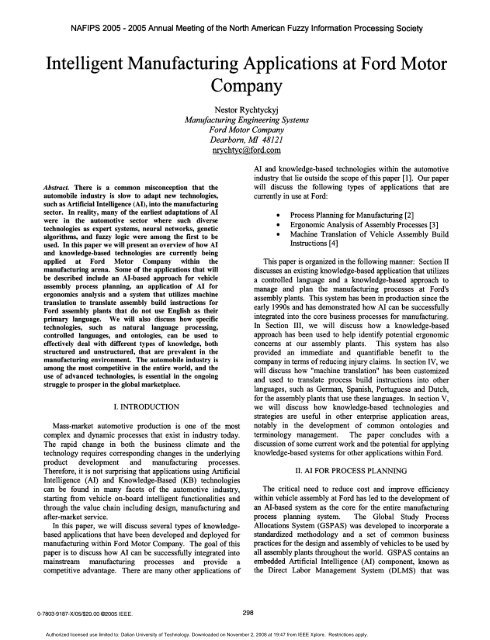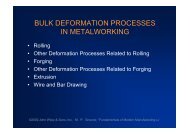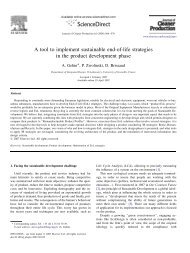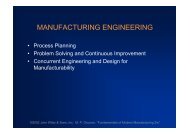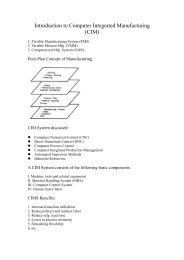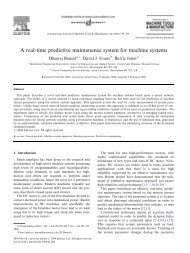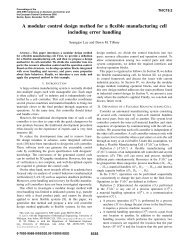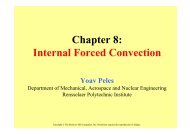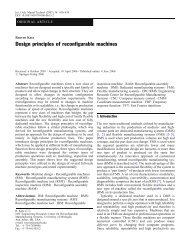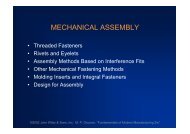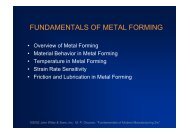24. Intelligent Manufacturing Applications at Ford Motor Company.pdf
24. Intelligent Manufacturing Applications at Ford Motor Company.pdf
24. Intelligent Manufacturing Applications at Ford Motor Company.pdf
Create successful ePaper yourself
Turn your PDF publications into a flip-book with our unique Google optimized e-Paper software.
NAFIPS 2005 - 2005 Annual Meeting of the North American Fuzzy Inform<strong>at</strong>ion Processing Society<strong>Intelligent</strong> <strong>Manufacturing</strong> <strong>Applic<strong>at</strong>ions</strong> <strong>at</strong> <strong>Ford</strong> <strong>Motor</strong><strong>Company</strong>Nestor Rychtyckyj<strong>Manufacturing</strong> Engineering Systems<strong>Ford</strong> <strong>Motor</strong> <strong>Company</strong>Dearborn, MJ 48121nrychtyc@ford.comAbstract. There is a common misconception th<strong>at</strong> theautomobile industry is slow to adapt new technologies,such as Artificial Intelligence (Al), into the manufacturingsector. In reality, many of the earliest adapt<strong>at</strong>ions of AIwere in the automotive sector where such diversetechnologies as expert systems, neural networks, geneticalgorithms, and fuzzy logic were among the first to beused. In this paper we will present an overview of how Aland knowledge-based technologies are currently beingapplied <strong>at</strong> <strong>Ford</strong> <strong>Motor</strong> <strong>Company</strong> within themanufacturing arena. Some of the applic<strong>at</strong>ions th<strong>at</strong> willbe described include an Al-based approach for vehicleassembly process planning, an applic<strong>at</strong>ion of Al forergonomics analysis and a system th<strong>at</strong> utilizes machinetransl<strong>at</strong>ion to transl<strong>at</strong>e assembly build instructions for<strong>Ford</strong> assembly plants th<strong>at</strong> do not use English as theirprimary language. We will also discuss how specifictechnologies, such as n<strong>at</strong>ural language processing,controlled languages, and ontologies, can be used toeffectively deal with different types of knowledge, bothstructured and unstructured, th<strong>at</strong> are prevalent in themanufacturing environment. The automobile industry isamong the most competitive in the entire world, and theuse of advanced technologies, is essential in the ongoingstruggle to prosper in the global marketplace.I. INTRODUCTIONMass-market automotive production is one of the mostcomplex and dynamic processes th<strong>at</strong> exist in industry today.The rapid change in both the business clim<strong>at</strong>e and thetechnology requires corresponding changes in the underlyingproduct development and manufacturing processes.Therefore, it is not surprising th<strong>at</strong> applic<strong>at</strong>ions using ArtificialIntelligence (Al) and Knowledge-Based (KB) technologiescan be found in many facets of the automotive industry,starting from vehicle on-board intelligent functionalities andthrough the value chain including design, manufacturing andafter-market service.In this paper, we will discuss several types of knowledgebasedapplic<strong>at</strong>ions th<strong>at</strong> have been developed and deployed formanufacturing within <strong>Ford</strong> <strong>Motor</strong> <strong>Company</strong>. The goal of thispaper is to discuss how AI can be successfully integr<strong>at</strong>ed intomainstream manufacturing processes and provide acompetitive advantage. There are many other applic<strong>at</strong>ions ofAI and knowledge-based technologies within the automotiveindustry th<strong>at</strong> lie outside the scope of this paper [1]. Our paperwill discuss the following types of applic<strong>at</strong>ions th<strong>at</strong> arecurrently in use <strong>at</strong> <strong>Ford</strong>:* Process Planning for <strong>Manufacturing</strong> [2]* Ergonomic Analysis of Assembly Processes [3]* Machine Transl<strong>at</strong>ion of Vehicle Assembly BuildInstructions [4]This paper is organized in the following manner: Section IIdiscusses an existing knowledge-based applic<strong>at</strong>ion th<strong>at</strong> utilizesa controlled language and a knowledge-based approach tomanage and plan the manufacturing processes <strong>at</strong> <strong>Ford</strong>'sassembly plants. This system has been in production since theearly 1990s and has demonstr<strong>at</strong>ed how Al can be successfullyintegr<strong>at</strong>ed into the core business processes for manufacturing.In Section III, we will discuss how a knowledge-basedapproach has been used to help identify potential ergonomicconcems <strong>at</strong> our assembly plants. This system has alsoprovided an immedi<strong>at</strong>e and quantifiable benefit to thecompany in terms of reducing injury claims. In section IV, wewill discuss how "machine transl<strong>at</strong>ion" has been customizedand used to transl<strong>at</strong>e process build instructions into otherlanguages, such as German, Spanish, Portuguese and Dutch,for the assembly plants th<strong>at</strong> use these languages. In section V,we will discuss how knowledge-based technologies andstr<strong>at</strong>egies are useful in other enterprise applic<strong>at</strong>ion areas,notably in the development of common ontologies andterminology management. The paper concludes with adiscussion of some current work and the potential for applyingknowledge-based systems for other applic<strong>at</strong>ions within <strong>Ford</strong>.II. Al FOR PROCESS PLANNINGThe critical need to reduce cost and improve efficiencywithin vehicle assembly <strong>at</strong> <strong>Ford</strong> has led to the development ofan Al-based system as the core for the entire manufacturingprocess planning system. The Global Study ProcessAlloc<strong>at</strong>ions System (GSPAS) was developed to incorpor<strong>at</strong>e astandardized methodology and a set of common businesspractices for the design and assembly of vehicles to be used byall assembly plants throughout the world. GSPAS contains anembedded Artificial Intelligence (Al) component, known asthe Direct Labor Management System (DLMS) th<strong>at</strong> was0-7803-91 87-X/05/$20.00 ©2005 IEEE. 298Authorized licensed use limited to: Dalian University of Technology. Downloaded on November 2, 2008 <strong>at</strong> 19:47 from IEEE Xplore. Restrictions apply.
concept A subsumes concept B if, and only if, the set denotedby concept A includes the set denoted by concept B. The KL-ONE knowledge base can be described as a network ofconcepts with the general concepts being closer to the root ofthe tree and the more specific concepts being the leaves of thetree. A concept in the knowledge base inherits <strong>at</strong>tributes fromthe nodes th<strong>at</strong> subsume it. The power of the knowledgerepresent<strong>at</strong>ion system lies in the classific<strong>at</strong>ion scheme. Thesystem will place a new concept into its appropri<strong>at</strong>e place inthe taxonomy by utilizing the subsumption rel<strong>at</strong>ion on theconcept's <strong>at</strong>tributes.The GSPAS Al system interprets these instructions andgener<strong>at</strong>es a list of detailed actions th<strong>at</strong> are required toimplement these instructions <strong>at</strong> the assembly plant level.These work instructions, known as "alloc<strong>at</strong>able elements," areassoci<strong>at</strong>ed with MODAPTS (MODular Arrangement ofPredetermined Time Standards) codes th<strong>at</strong> are used tocalcul<strong>at</strong>e the time required to perform these actions.MODAPTS codes are widely utilized as a means of measuringthe body movements th<strong>at</strong> are required to perform a physicalaction and have been accepted as a valid work measurementsystem [9]. For example, the MODAPTS code for moving asmall object with only a hand is M2; utilizing the arm gives acode of M3. The MODAPTS codes are then combined todescribe a entire sequence of actions. MODAPTS codes arethen converted into an equivalent time required to perform th<strong>at</strong>action. The output from the GSPAS Al system is sent to theappropri<strong>at</strong>e assembly plants where the vehicle in question isbeing built. Engineers <strong>at</strong> the assembly plant then alloc<strong>at</strong>e thejob instructions among the available assembly oper<strong>at</strong>ors. Thefollowing two figures display an example of StandardLanguage. Figure I shows a sample of a process sheet writtenin Standard Language. Figure 2 shows the results th<strong>at</strong> aregener<strong>at</strong>ed by the Al system for line 20 of the process sheet.The MODAPTS codes for each instruction are printed <strong>at</strong> theback of the line. Figure 3 displays the DLMS systemarchitecture and Figure 4 shows a small portion of theknowledge base.Resulting Work Instructions Gener<strong>at</strong>ed by DLMS ForLine 20LOOSEN HEATER ASSEMBLY TURNSCREW USING POWER TOOLGRASP POWER TOOL (RT ANGLE NUTRUNNER) POSITION POWER TOOL (RT ANGLE NUTRUNNER) ACTIVATE POWER TOOL (RT ANGLE NUTRUNNER) REMOVE POWER TOOL (RT ANGLE NUTRUNNER) RELEASE POWER TOOL (RT ANGLE NUTRUNNER) Figure 2.The use of a standardized methodology and process for allvehicle programs allows us define and use a consistentapproach to the manufacturing process across multiple vehiclelines and assembly plants. Another significant advantage tousing a knowledge-based approach is easy maintainability.Since the original Al system has gone into production, wehave made thousands of changes to the knowledge base inorder to keep current with the very dynamic pace of theautomotive industry. These changes include the following:* Normal replacement and introduction of new vehicles.* Improvements and changes to the manufacturingprocess.* Introduction ofnew tooling and parts.* Introduction of new technologies, such as hybridvehicles and s<strong>at</strong>ellite radio.* Changes to the external business, such as the purchaseof Volvo and Land Rover.* Changes to the terminology in Standard Language.We have found th<strong>at</strong> our approach to building and maintaininga knowledge base using "description logics" has proven to bevery successful.System ArchitectureProcess Sheet Written in Standard LanguageTITLE: ASSEMBLE IMMERSION HEATER TO ENGINE10 OBTAIN ENGINE BLOCK HEATER ASSEMBLY FROM STOCK20 LOOSEN HEATER ASSEMBLY TURNSCREW USING POWERTOOL30 APPLY GREASE TO RUBBER O-RING AND CORE OPENING40 INSERT HEATER ASSEMBLY INTO RIGHT REAR CORE PLUGHOSE50 ALIGN SCREW HEAD TO TOP OF HEATERTOOL 20 1 P AAPTCA TSEQ RT ANGLE NUTRUNNERTOOL 30 1 C COMM TSEQ GREASE BRUSHFigure 1.Figure 3: GSPAS Al architecture300Authorized licensed use limited to: Dalian University of Technology. Downloaded on November 2, 2008 <strong>at</strong> 19:47 from IEEE Xplore. Restrictions apply.
Knowledge BaseFigure 4: Portion of GSPAS Al knowledge baseIII. AI FOR ERGONOMIC ANALYSISAt the 6th Annual Applied Ergonomics Conference held inDallas, Texas in March of 2003, the Institute of IndustrialEngineers (IIE) awarded the "Ergo Cup" in Training &Educ<strong>at</strong>ion to <strong>Ford</strong> <strong>Motor</strong> <strong>Company</strong> for the GSPASErgonomics Applic<strong>at</strong>ion. <strong>Ford</strong> <strong>Motor</strong> <strong>Company</strong> has beenutilizing an integr<strong>at</strong>ed process planning system since 1990 tostandardize the process sheet writing, cre<strong>at</strong>e work alloc<strong>at</strong>ionsfor the plant floor and to estim<strong>at</strong>e labor time accur<strong>at</strong>ely. Thissystem, formerly known as the Direct Labor ManagementSystem (DLMS) is a knowledge-based system th<strong>at</strong> utilizes asemantic network knowledge represent<strong>at</strong>ion scheme. DLMSutilizes techniques from n<strong>at</strong>ural language processing,description logics and classific<strong>at</strong>ion-based reasoning togener<strong>at</strong>e detailed plant floor assembly instructions from highlevelprocess descriptions. This system also provides detailedestim<strong>at</strong>es of the labor content th<strong>at</strong> is required from theseprocess descriptions. Techniques, such as machine transl<strong>at</strong>ionand evolutionary comput<strong>at</strong>ion, were integr<strong>at</strong>ed into DLMS tosupport knowledge base maintenance and to deploy DLMS to<strong>Ford</strong>'s assembly plants th<strong>at</strong> do not use English as their mainlanguage.The process sheet is the primary vehicle for conveyingvehicle assembly inform<strong>at</strong>ion from the central engineeringfunctions to the assembly plants. It contains specificinform<strong>at</strong>ion about work instructions and describes the partsand tools required for the build process. The work th<strong>at</strong> isrequired to build the vehicle according to the process sheetinstructions is then alloc<strong>at</strong>ed among the available personnel.Work alloc<strong>at</strong>ion requires a precise means of measuring thelabor time th<strong>at</strong> is needed for any particular task. The DLMSsystem interprets these instructions and gener<strong>at</strong>es a list ofdetailed actions th<strong>at</strong> are required to implement theseinstructions <strong>at</strong> the assembly plant level.Subsequently, the ergonomics engineers would manuallyinspect the process sheets for possible ergonomic problems.Since there may be 2000 or more process sheets for everysingle type of vehicle th<strong>at</strong> <strong>Ford</strong> manufactures, this manualtype of inspection was very labor intensive and timeconsuming.An ergonomics engineer would spend upwards oftwo weeks in manually inspecting each process buildinstruction for a vehicle.In an effort to streamline this process, we developed asystem th<strong>at</strong> would autom<strong>at</strong>e the inspection of process sheetsfor ergonomics concerns. This work resulted in thedevelopment of an AI system for ergonomic analysis withinGSPAS th<strong>at</strong> checks for two types of potential ergonomicsissues: "red" and "warning." Process sheets th<strong>at</strong> are flagged as"red" will not be sent to the assembly plants until those errorsare corrected. Process sheets th<strong>at</strong> are flagged with "warning"messages are released to the assembly plants; however, theergonomic specialists have the opportunity to check andapprove these processes.The Ergonomics system was developed and deployed toproduction in April of 2002. This has already resulted in asavings of over $17,000,000 in injury cost avoidance as thehigh risk processes never made it to the plant floor. Thesecalcul<strong>at</strong>ions are based on the type of injuries prevented and thedirect cost associ<strong>at</strong>ed per injury for each type of ergonomicproblem.IV. MACHINE TRANSLATIONWe have been utilizing a Machine Transl<strong>at</strong>ion system <strong>at</strong><strong>Ford</strong> <strong>Motor</strong> <strong>Company</strong> since 1998 within Vehicle Oper<strong>at</strong>ionsfor the transl<strong>at</strong>ion of our process assembly build instructionsfrom English to German, Spanish, Portuguese and Dutch.This system was developed in conjunction with SystranSoftware Inc. and is an integral part of our worldwide processplanning system for manufacturing assembly. The input toour system is a set of process build instructions th<strong>at</strong> are writtenusing a controlled language known as Standard Language.The process sheets are read by an AI system th<strong>at</strong> parses theinstructions and cre<strong>at</strong>es detailed work tasks for each step ofthe assembly process. These work tasks are then released tothe assembly plants where specific workers are alloc<strong>at</strong>ed foreach task. In order to support the assembly of vehicles <strong>at</strong>plants where the workers do not speak English, we utilizeMachine Transl<strong>at</strong>ion (MT) technology to transl<strong>at</strong>e theseinstructions into the n<strong>at</strong>ive language of these workers.Standard Language is a restricted subset of English andcontains a limited vocabulary of about 5000 words th<strong>at</strong> alsoinclude acronyms, abbrevi<strong>at</strong>ions, proper nouns and other <strong>Ford</strong>specificterminology. In addition, Standard Language allowsthe process sheet writers to embed comments within StandardLanguage sentences. These comments are ignored by the Alsystem during its processing, but have to be transl<strong>at</strong>ed by theMT system. Standard Language also utilizes some structuresth<strong>at</strong> are gramm<strong>at</strong>ically incorrect and cre<strong>at</strong>e problems duringthe MT process. Therefore, the development of a transl<strong>at</strong>ionsystem for these requirements entailed considerablecustomiz<strong>at</strong>ion to the SYSTRAN transl<strong>at</strong>ion engines as well asa lot of effort in building the technical glossaries to enable301Authorized licensed use limited to: Dalian University of Technology. Downloaded on November 2, 2008 <strong>at</strong> 19:47 from IEEE Xplore. Restrictions apply.
correct transl<strong>at</strong>ion of <strong>Ford</strong>-specific manufacturingterminology.Since Standard Language is constantly changing andevolving, it is necessary to keep the transl<strong>at</strong>ion glossaries upto-d<strong>at</strong>e.It is also very critical to ensure th<strong>at</strong> any changes tothe transl<strong>at</strong>ion glossaries do not adversely impact any currenttransl<strong>at</strong>ions. This requirement led to development of a processto maintain and improve the accuracy of the transl<strong>at</strong>ionglossaries and includes the following components:* The cre<strong>at</strong>ion of a test corpus th<strong>at</strong> contains a set ofsample process build instructions along with theexpected transl<strong>at</strong>ions for each target language.* The cre<strong>at</strong>ion and use of language modeling utilitiesth<strong>at</strong> allow us to analyze Standard Language anddetermine the usage frequency of terms and phrases.* A web-based system, known as the Systran ReviewManager, which allows users to maintain and addterminology to the technical glossaries.The use of Machine Transl<strong>at</strong>ion technology has allowed us totransl<strong>at</strong>e large amounts if d<strong>at</strong>a in a very cost-effective manner.The accuracy of the transl<strong>at</strong>ion depends on the scope of thetransl<strong>at</strong>ion glossaries th<strong>at</strong> need to be developed for the <strong>Ford</strong>specificterminology. Our benchmarking has shown th<strong>at</strong> theEnglish-German transl<strong>at</strong>ions are 95% accur<strong>at</strong>e; otherlanguages are less accur<strong>at</strong>e, but this will improve as thetransl<strong>at</strong>ion glossaries are expanded for each language pair.We also hope to improve the accuracy of the transl<strong>at</strong>ionprograms through the use of tagging technology, where thesource language text will contain XML tags with inform<strong>at</strong>ionth<strong>at</strong> allows the transl<strong>at</strong>ion engine to make better decisionsabout the source text.V. KNOWLEDGE MANAGEMENTAll of the systems described above are closely coupled withother manufacturing and product development systems. Thesesystems often use terminology th<strong>at</strong> does not m<strong>at</strong>ch the termsused within our knowledge bases. In addition, there is a lot ofunstructured knowledge th<strong>at</strong> contains inform<strong>at</strong>ion about"lessons learned," "best practices" and other specificknowledge th<strong>at</strong> needs to be integr<strong>at</strong>ed into our systems. It isextremely difficult to extract the appropri<strong>at</strong>e knowledge fromthese different d<strong>at</strong>a sources and present it to the user in <strong>at</strong>imely and useful fashion.One example of knowledge integr<strong>at</strong>ion is the need to beable to m<strong>at</strong>ch part descriptions from the part d<strong>at</strong>abase with theinform<strong>at</strong>ion provided in the process sheet. The process sheetis written in Standard Language and the parts d<strong>at</strong>abase doesnot have this requirement. Our ergonomics processingrequires us to m<strong>at</strong>ch the part from the process sheet with thepart description; if they m<strong>at</strong>ch - we then perform someprocessing based on the part weight. In this case, many partshave multiple written represent<strong>at</strong>ions, but represent one singlepart. We need to accommod<strong>at</strong>e acronyms, synonyms,abbrevi<strong>at</strong>ions, misspellings, misplaced punctu<strong>at</strong>ion and otherproblems inherent in n<strong>at</strong>ural language. The accuracy of ourergonomics analysis depends on how well we can find theappropri<strong>at</strong>e part in the d<strong>at</strong>abase and this requires more than asimple word m<strong>at</strong>ch. Therefore, we need to build commonontologies th<strong>at</strong> will allow us to m<strong>at</strong>ch concepts from differentknowledge sources and leverage this inform<strong>at</strong>ion across theentire manufacturing and product development world. Ourfuture plans will focus on integr<strong>at</strong>ing unstructured knowledgefrom different sources, building a common ontologyframework and enabling our systems to communic<strong>at</strong>e andexchange knowledge among themselves.VI. CONCLUSIONSIn this paper, we have discussed several applic<strong>at</strong>ions withinthe manufacturing arena <strong>at</strong> <strong>Ford</strong> <strong>Motor</strong> <strong>Company</strong> th<strong>at</strong> use Aland knowledge-based approached to solve critical businessproblems. The GSPAS Al system th<strong>at</strong> <strong>Ford</strong> uses for processplanning has been in production for over ten years. It is usedthroughout the assembly plants to estim<strong>at</strong>e the work th<strong>at</strong> isneeded to build any given vehicle within <strong>Ford</strong>. We have alsobuilt a knowledge base th<strong>at</strong> contains all the inform<strong>at</strong>ionneeded to build a vehicle and have implemented StandardLanguage throughout <strong>Ford</strong> as part of the manufacturingprocess. Our success with the GSPAS Al system has allowedus to expand the usage of this technology into otherapplic<strong>at</strong>ion areas, such as Ergonomics and MachineTransl<strong>at</strong>ion. We feel th<strong>at</strong> these systems provide us acompetitive advantage in the manufacturing area and showhow these technologies can be utilized for other applic<strong>at</strong>ions.References[1] Gusikhin, 0 and Rychtyckyj, N., (2004), "Al <strong>Applic<strong>at</strong>ions</strong> in theAutomotive Industry", Proceedings ofthe Workshop on <strong>Intelligent</strong> Computing<strong>at</strong> the 3rd Mexican Intern<strong>at</strong>ional Conference on Artificial Intelligence, MexicoCity, Mexico, April 26-30, 2004, pp. 7-16.[2] Rychtyckyj, N., (1999), "DLMS: Ten Years of AI for Vehicle AssemblyProcess Planning", AAAI-99/ILAI-99 Proceedings, Orlando, FL, July 18-22,1999, pp. 821-828, AAAI Press.[3] Rychtyckyj, Nestor (2004), "Ergonomics Analysis for Vehicle AssemblyUsing Artificial Intelligence", Proceedings of the 16th Conference onInnov<strong>at</strong>ive <strong>Applic<strong>at</strong>ions</strong> ofArtificial Intelligence, July 25-29, 2004, San Jose,CA, pp. 793-798.[4] Rychtyckyj, N., (2002), "An Assessment of Machine Transl<strong>at</strong>ion forVehicle Assembly Process Planning <strong>at</strong> <strong>Ford</strong> <strong>Motor</strong> <strong>Company</strong>'", MachineTransl<strong>at</strong>ion: From Research to Real Users, 5th Conference of the Associ<strong>at</strong>ionfor Machine Transl<strong>at</strong>ion in the Americas, AMTA 2002 Tiburon, CA, USA,October 2002 Proceedings, pp. 207-215, Springer-Verlag.[5] Klampfl, E., Gusikhin, O., Rossi, G., (2004), e-Workcell Applic<strong>at</strong>ion in amixed-model automotive assembly environment, Proceedings of2004JUSFA, 2001 Japan - USA Symposium of Flexible Autom<strong>at</strong>ion, Denver,Colorado, July 19-21, UL_035.[6] Huijsen, Willem-Olaf (1998), "Controlled Language - An Introduction",in the Proceedings of the Second Intern<strong>at</strong>ional Workshop on ControlledLanguage <strong>Applic<strong>at</strong>ions</strong> (CLAW 98), May 21-22, 1998, LanguageTechnologies Institute, Carnegie Mellon University, Pittsburgh, PA, pp. 1-15.[7] McGuiness, D. and P<strong>at</strong>el-Schneider, P. 1998. Usability Issues inKnowledge Represent<strong>at</strong>ions Systems. In Proceedings of the FifteenthN<strong>at</strong>ional Conference on Artificial Intelligence, 608-614. Menlo Park, CA:AAAI Press.[8] Brachman, R., Schmolze, J. 1985. An Overview of the KL-ONEKnowledge Represent<strong>at</strong>ion System. Cognitive Science 9(2): 171-216.[9] Carey, Farrell, Hui, and Sullivan (2001), Heyde's Modapts: A Languageof Work. Heyde Dynamics PTY LTD302Authorized licensed use limited to: Dalian University of Technology. Downloaded on November 2, 2008 <strong>at</strong> 19:47 from IEEE Xplore. Restrictions apply.


